Entries in Neon (81)
Venturi and Brown Revisit "Learning from Las Vegas"
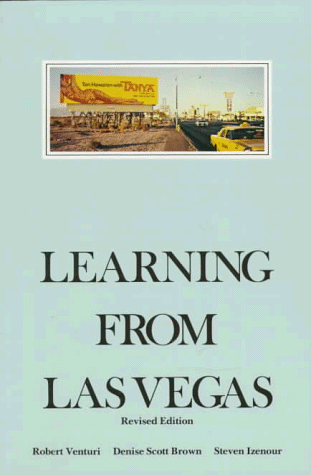
It is one of the iconic books about Las Vegas architecture, "Learning from Las Vegas". Written over forty years ago, this influential book, along with Alan Hess', "Viva Las Vegas: After-Hours Architecture", influences the way we look at the architecture of the Classic Las Vegas Strip.
Recently, Denise Scott Brown and Robert Venturi returned to Las Vegas to see how the landscape had changed in forty years. Their partner, Steven Izenour, passed away some time back.
From our pal Kristen Petersen at the Las Vegas Sun:
It’s 100 degrees. Everyone is sweating.
Architects Denise Scott Brown and Robert Venturi tour the Neon Boneyard, followed by a small crowd, some shaded by umbrellas. Cameras roll.
The Boneyard visit and a subsequent architectural bus tour are for a documentary on the architects whose famous 1968 study of Las Vegas launched an influential way of architectural thinking by observing what the people want, rather than what the architect dictates.
The project, begun five years ago by their son, Jim Venturi, delves into their working relationship, transformative years, observations, influences, ideas and projects, and has taken them around the world.
The Las Vegas stop is key. “Learning from Las Vegas,” a book of their study of the city as a prototype for 20th century American suburbia, became a formula for how they approached, and still approach, architecture.
Jim Venturi calls it a bedrock of his parents’ career, “the defining element that they are associated with by their willingness to look at things other people weren’t looking at.”
That the book remains topical in college curricula and contemporary conversation, even outside of architecture, is partly what inspired him.
“People had discovered their thinking and applied it outside the field,” he says. “Today you’ll find all kinds of interesting schools that are using ‘Learning from Las Vegas’ in the curriculum.”
Scott Brown, 77, and Venturi, 84, have received their share of criticism for their writings and designs — though they have their disciples and Venturi won the 1991 Pritzker Prize.
The film, Jim Venturi says, explains some of that: “You see the world from their perspective. You see their challenges. You learn about the experiences that shaped them.”
That, he says, includes their application of Eastern ideas and quest for balance.
John Halpern, known for his 1979 documentary on German artist Joseph Beuys, directs the film, one he says he would have given anything to be a part of: “Our main characters are amazing and complex.”
Halpern recalls Robert Venturi describing Palladio’s Basilica di San Giorgio Maggiore: “He revealed part of his mind, his mental process, his natural instinct for seeing art in its deeper meaning and esoteric impact. His sincerity, openness to and love of art and architecture moved me completely.”
Halpern describes Scott Brown as a powerful woman and architect, denied credibility in the “men’s club” of architecture. He’s also seen her open up:
“While describing her feelings and visionary ideas about architecture and the intricacies of city planning, (she) revealed a beautiful correlation between her body and sensorial experience in her art expression.”
Scott Brown says the project has been hard work, but has given them their lives back by revisiting the places where they shaped their ideas and careers.
Have they visited Vegas much?
“We have,” she says. “But who’s to know, this could be our last. But we say that everywhere.”
"Las Vegas: 1905-1965" Makes Great Summer Reading!


We've got copies!
Discover the real history of Las Vegas!
This is the book I wrote on the history of Las Vegas with lots of postcards, some rare and one of kind. Makes for great reading this summer!!
If you are flying to Vegas this summer or need a book to read while poolside, this is it. The story of Las Vegas told through postcard images. Images that are part of our collective memory, images that you may never have seen before, a look at Las Vegas beyond the neon and the glitter.
In short, the real history of Las Vegas as you've never experienced.
The book covers the history of Las Vegas from 1905 to 1965 and besides lots of interesting history about the Strip and the various original hotels, there's lots of history on the Roadside Architecture, the Motels, the Post-War era,and most of all, the Community.
Discover the real history of your favorite vacation spot or the place you call home!
It's a fun-filled book packed with info and lots of images of the Las Vegas you love and miss.
I've got copies of the book for sale and I'll autograph them as well!
http://www.classiclasvegas.com/coolstuff/coolstuff.htm
So, head on over and order your copy today!
A portion of the sales goes toward maintaining this blog and our historical preservation work so it's for a worthy cause!
Classic Las Vegas Neon Memories
This is our last installment of this week's walk down memory lane. Tomorrow, as promised, the point behind this trip down memory lane.
In the meantime, I hope you enjoy and remember these places:
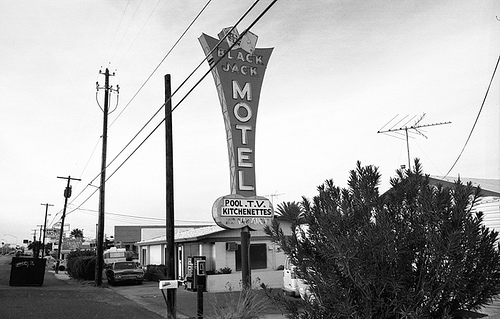
Blackjack Motel
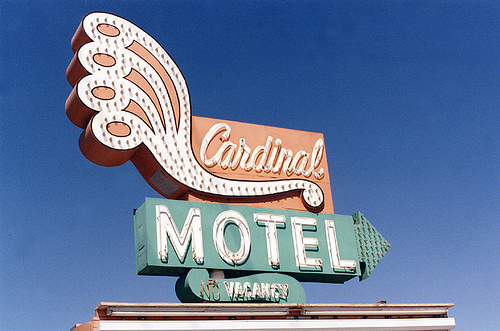
Cardinal Motel (gone)
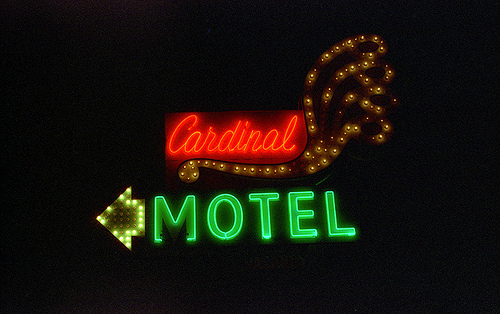
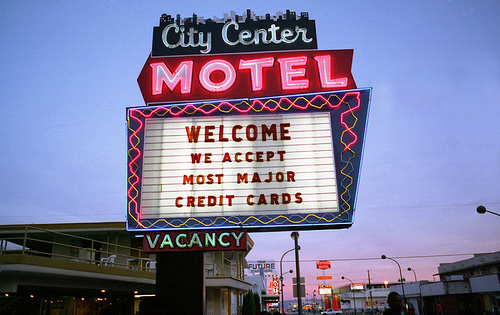
City Center Motel (gone)
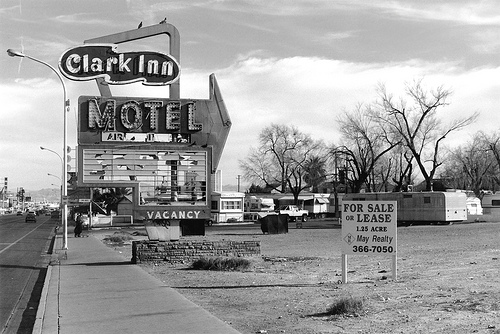
Clark Inn Motel sign (gone)
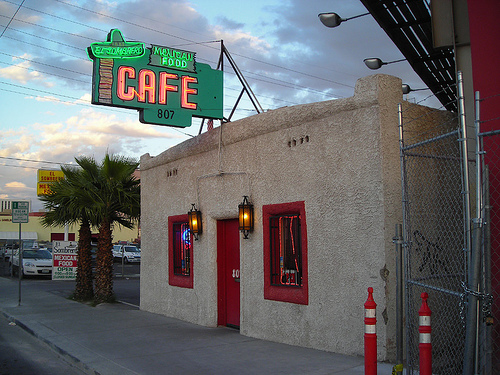
El Sombrero Cafe (thankfully still standing)
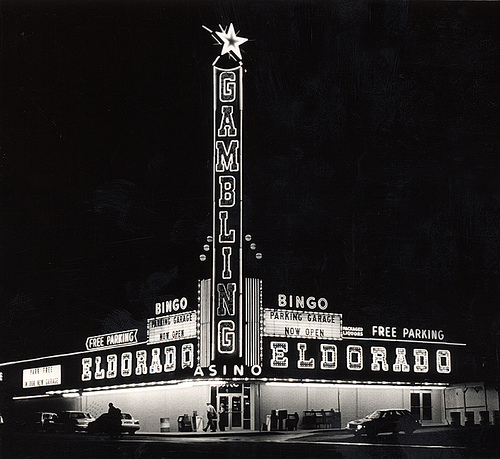
El Dorado Club, 1988
 Lucky Cuss Motel
Lucky Cuss Motel
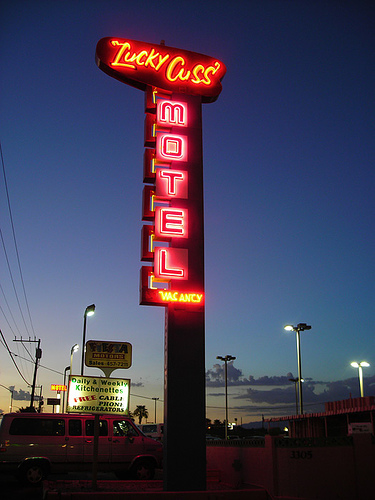
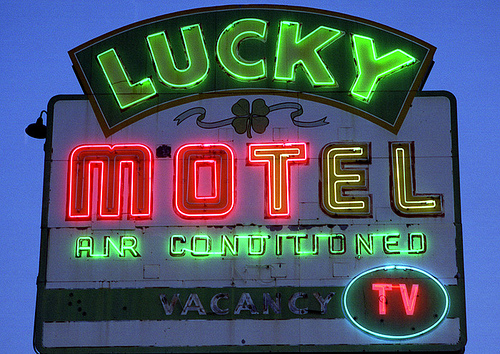
Lucky Motel (still standing) but the sign is now in a private collection
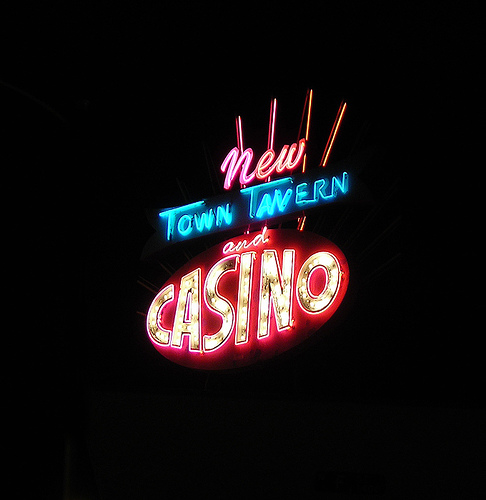
New Town Tavern (thankfully still standing)
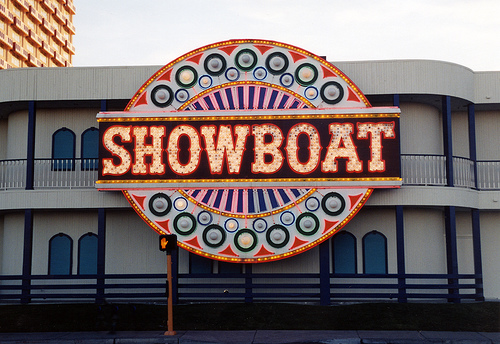
Showboat Sign (gone along with the Showboat)
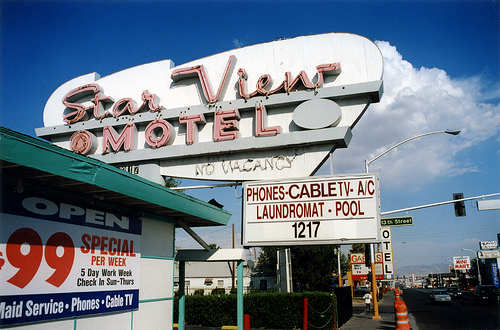
Star View Motel (still standing) but the sign has been drastically altered
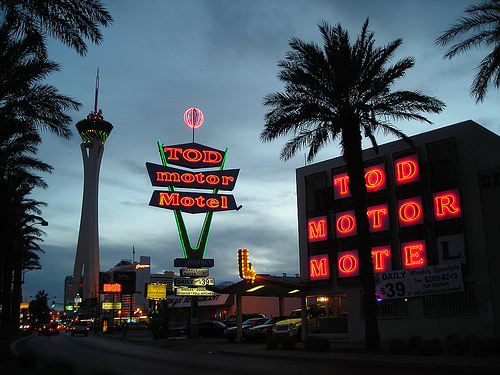
The Tod Motor Hotel (still going strong)
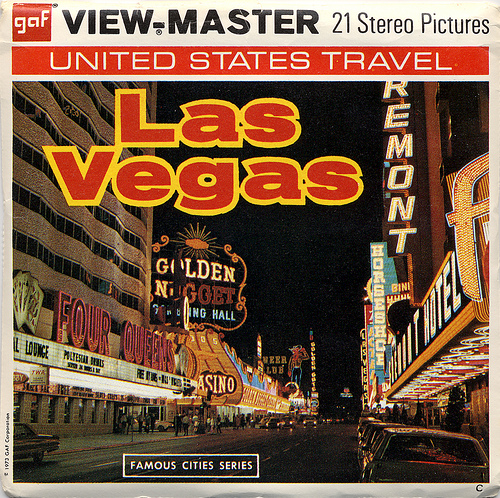
Fremont Street a long time ago
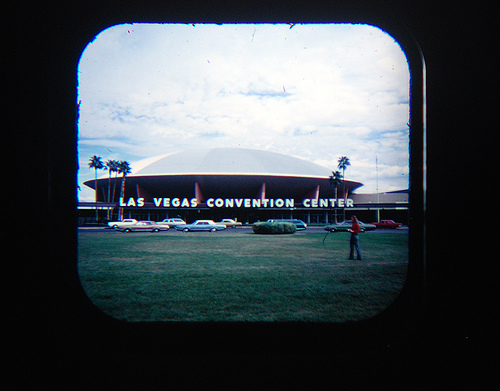
Las Vegas Convention Center Rotunda (gone)
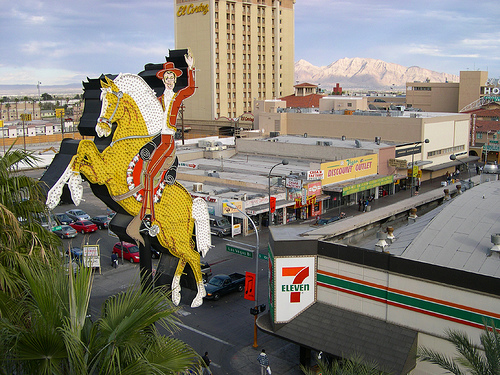
Hacienda Horse and Rider preserved and restored and riding over Fremont Street
More Classic Las Vegas Memories
How many of these do you remember?
There's a point to this extended journey down Memory Lane, I promise. In the meantime, I hope you enjoy!

The Dunes Hotel (gone) Matchbook art

Aqueduct Building, Sands Hotel, 1991 (gone)

The Hacienda Hotel (gone) circa 1973 (notice all that desert)

Holiday Casino, circa 1970s (gone)

The Landmark, 1973 (gone)

Landmark, circa 1980s (sign is in the Neon Boneyard)

Las Vegas Strip, circa 1980s with the El Morocco (gone) and the La Concha lobby(moved) and its hotel wing (gone) in the foreground.

The Silver Slipper, circa 1970s (gone)

Stardust Hotel, circa early 1960s (gone)

Tropicana Hotel (signage gone) circa 1973
Thanks to Allen Sandquist (RoadsidePictures) for letting us use these images.

Welcome to Las Vegas Sign now part of the National Register of Historic Places!
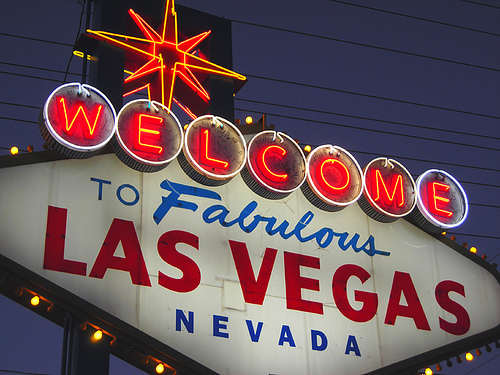
Betty Willis' "little sign that could" has been added to the National Register of Historic Places!
The “Welcome to Fabulous Las Vegas” sign has been listed in the National Register of Historic Places, a significant milestone in the sign’s 50-year history, county and state officials announced today.
“We nominated the sign as part of our centennial celebration, believing wholeheartedly in this Las Vegas icon’s historic value,” said County Commission Chairman Rory Reid, whose district includes the sign. “This designation demonstrates that the keepers of the National Register agree. The sign has been not only an important symbol for our community but a magnet for untold thousands who have had their pictures taken in front of it.”
Nevada Historic Preservation Officer Ron James, whose office forwarded the county’s application to the National Park Service for consideration, said the Register is the nation’s official list of cultural resources worthy of recognition and preservation.
“This sign is one of the most recognizable images associated with Nevada and its tourism industry,” said James. “This national honor underscores the historic value of the sign.”
The Welcome sign is located on the median of Las Vegas Boulevard in unincorporated Clark County, just south of the Russell Road exit on Interstate 15. It reads, “Welcome to Fabulous Las Vegas, Nevada” on the front and “Drive Carefully” and “Come Back Soon” on the back.
The sign is owned by Young Electric Sign Company (YESCO) and leased to Clark County. "As owner of the Welcome to Fabulous Las Vegas sign, YESCO is proud to be the stewards of this important cultural resource which has done so much to promote a positive, vibrant image for Las Vegas and Clark County for the past 50 years," said John Williams, the company’s vice president and general manager.
The sign was designed by Betty Whitehead Willis of Western Neon, at the time one of a few women in the nation working as sign designers. In 1959 a group of Strip hotel owners asked the Clark County Commission to fund the design and construction of a sign to welcome visitors to Las Vegas. The winning bid, from Western Neon, was for $4,000. Later, YESCO bought out Western Neon and became the sign’s owner
The Welcome sign was placed on the old U.S. Highway 91, which was the main route from Southern California. The closest hotel was the Hacienda, located where Mandalay Bay is now. Clark County Commission meeting minutes in May 1959 note that the sign was to be located just north of the old McCarran airport. It is still at that location, although the main route for travelers is now I-15, and the old McCarran airport is now Signature Executive Terminal.
In the 1990s, another group of hotel owners, thinking the sign had outlived its day, commissioned a study to determine whether a new structure should be built. A public outcry followed and the sign remained. Although YESCO owns the trademark, the image of Welcome sign was never copyrighted, so it has been used freely for commercial and non-commercial purposes over the decades. As a result, it is recognizable internationally and the Welcome sign’s popularity as a tourist destination and photo opportunity continues to grow.
In January, Clark County completed work on a parking lot in the median just south of the sign to enable individuals and groups to safely take pictures of the sign without having to park on the side of the road and run across three lanes of traffic to get there. The new lot also provides access to the sign for the disabled for the first time. Access to the sign had been somewhat limited since its creation in 1959. The new lot features 12 parking spots, including two for the disabled, plus space for two buses.
This year marks the 50th anniversary of the installation of the Welcome sign, which has marked the southern approach to the Strip since 1959.
The county, in its application for placement in the Register, argued that the sign meets National Park Service criteria for being historically significant in these ways:
- “...For its association with the post-World War II entertainment, tourism and advertising industries.The 1950s saw an explosion of casino construction on the Las Vegas Strip, and the 1959 Welcome sign represented the optimism and boosterism of Las Vegas casino owners and civic leaders. The fifties also saw the development of national advertising into a fine art, which made Las Vegas a most desired tourist destination and indeed, a household word across the country and around the world.”
- “Designer Betty Whitehead Willis was a Las Vegas native and daughter of a pioneer southern Nevada family. She attended art school in Los Angeles and had a career as a graphic designer before becoming a sign designer in the early fifties. Willis also designed, among others, the locally treasured Blue Angel Motel sign, and the 1955 Moulin Rouge Hotel and Casino sign.”
- “...As an excellent example of Exaggerated Modern/Googie architecture (1940s-1960s). The sign utilizes a stretched diamond shape with curved sides, set against an angular double column, outlined with light bulbs to accentuate the unusual shape, which are characteristics of Exaggerated Modern/Googie. The sign has become a cultural icon, known and loved around the world, not just because of its historical value and association with Las Vegas, but also because it is one of the dwindling examples of Exaggerated Modern in the southwest and especially in Las Vegas.”



